Agents of Doom: Who is creating the apocalypse and why
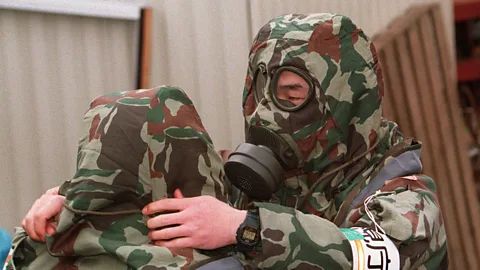 Yoshikazu Tsuno/Getty Images
Yoshikazu Tsuno/Getty ImagesThere are a handful of actors who are the most likely to cause a global catastrophe, but their power goes unchecked, says Luke Kemp.
In 1995, a doomsday cult in Japan killed 13 people and injured more than 6,000 others. They were the victims of a Sarin gas attack in the Tokyo subway committed during rush hour by the apocalyptic terrorist group known as Aleph (at the time called Aum Shinrikyo). Afterwards, 13 of the perpetrators were tried and executed.
One of the metro lines attacked on that day (the Marunouchi Line) leads to Shinjuku Station. Shinjuku is home to numerous sites where the Japanese government allegedly buried the bodies of the victims of wartime experiments. The corpses are purported to have been the grisly result of the actions of Unit 731: Japan’s infamous World War Two biological weapons programme.
Over more than a decade, Unit 731 was responsible for perhaps 300,000 or more deaths. The programme experimented with weaponising a host of biological agents, from botulism and bubonic plague to syphilis and smallpox. New deployment methods were trialed, including the dropping of plague-infected fleas onto Chinese cities. Unit 731 engaged in some of the worst atrocities imaginable, including the live vivisection of prisoners.
After WW2 came to an end and Japan surrendered, the scientists of Unit 731 were granted immunity by the US. In exchange for avoiding prosecution for war crimes, they handed over data from human experimentation and bioweapons research to the US (although not its allies).
The story of Aum Shinrikyo is well known and discussed among scholars who study global catastrophe and human extinction. It is frequently used as an example of the dangers if terrorists with apocalyptic motivations are well-funded and scientifically-literate.
Unit 731 is far less analysed. This is despite the fact that it illustrates the chilling lengths powerful actors can and will go to for an advantage. In addition to the harms caused to the Chinese people and others, Unit 731 could also have had terrible consequences for the global population, if its weaponised biological arsenal had been more extensively developed or widely deployed.
Instead, many catastrophic risk researchers focus on a "citizen terror narrative", concerned with "agential risks": doomsday level-threats from minor actors such as ambitious terrorists. Across the masses of citizens, the concern is that there will be at least one individual or group motivated to bring about Ragnarök. Hence, one of the greatest problems is the increased availability of dangerous information and technologies. Some have even suggested that preventive policing and ubiquitous surveillance may be required to control these hypothetical wide-spread weapons of mass destruction.
With this view, the most powerful are trusted to not destroy the world due to rational self-interest. As the UK's Astronomer Royal Lord Martin Rees frames it in his book Our Final Century, a human-triggered apocalypse would likely be a case of "terror or error": malicious action by a small group or a mistake by the powerful.
 Noboru Hasimoto/Getty Images
Noboru Hasimoto/Getty ImagesTerrorists and lone wolves are undoubtedly a problem. However, it appears they are highly unlikely to be the source of global destruction. The historical and present reality of human-made global hazards suggests that a different set of actors are culpable. Destroying large swathes of the world requires power and secrecy.
For the past few years, I have been studying the forces that cause historical catastrophes and collapses, as well as working with colleagues at the University of Cambridge's Centre for the Study of Existential Risk to analyse the modern dangers we face in the present-day. (Read more: Are we on the road to civilisation collapse?)
During my research I have become convinced that only a few institutions have the resources – and lack of oversight – to imperil the world. This is an enduring predicament that is unlikely to change. The greatest threats are not born from average citizens, but from a desire from the powerful for control, profit, and military advantage.
Read more:
Scholars of castastophic risk often point to a handful of infamous human-made global threats: artificial general intelligence (AGI), catastrophic biological threats, climate change, lethal autonomous weapons, nuclear weapons and mass surveillance. The impact of each of these threats is uncertain and some are more likely than others: we have already experienced around 1C of global warming since industrialisation, but whether AGI can or will be created is uncertain. They are best thought of as interconnected threats that could cause significant worldwide loss of life and liberty.
All of these are the product of a small group of often overlapping, powerful industries dominated by a few actors. These are primarily: military-industrial complexes, the fossil fuel industry and Big Tech. All of these are concentrated in a handful of countries, particularly the US. Let us call them the Agents of Doom.
Global catastrophe is a case of public costs and private benefits. Too often we mistakenly think of the future of global catastrophe as a set of (falsely) separate hazards and technologies. The true risk underlying all of these is unaccountable, concentrated power.
Artificial general intelligence (AGI)
Some scholars are concerned that the creation of advanced artificial intelligence could have dire impacts. In 2020, approximately 72 projects were openly researching AGI across 37 countries. These are primarily corporate and academic projects. About half of these are in the US and eight of the nine projects that have military connections are in the US. These can be taken as an underestimate as existing military programmes are likely to be kept confidential.
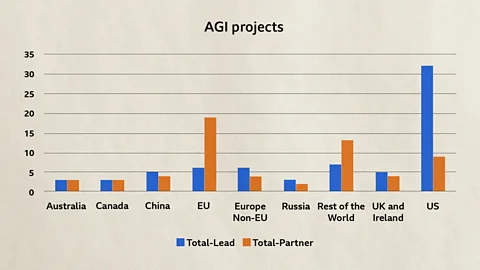 Luke Kemp/Javier Hirschfeld
Luke Kemp/Javier Hirschfeld(Note: "lead" designates countries where the projects' administrative and operational leadership are located. "Partner" refers to countries contributing to a project involving other nations.)
Catastrophic biological threats
The intentional development and cultivation of bioweapons didn’t truly begin until around World War One. Approximately 11 countries had bioweapons programmes over the course of the 20th Century resulting in around 18 bioweapons related incidents. The worst act during this time was the use of Typhus, Cholera and other agents by the Japanese (namely through Unit 731) against China during WW2.
Bioterrorism has been more frequent but less impactful. A survey of multiple studies suggests an average incident rate of 0.35-3.5 for biocrime and bioterrorism (in other words, approximately one every 2.9 years to 3.5 every year). But this includes a large number of hoaxes and threats. The vast majority of actual attacks result in a few casualties at most. This has led some researchers to conclude "even if considerable financial, structural and logistical resources are available, successfully delivering a large-scale biological attack is harder than it may seem to be". In contrast, scholars note that the revolution in biotechnology will be one that likely gives an enormous advantage to stronger, militarised states.
Climate change
Just 100 companies are responsible for 71% of global industrial greenhouse gas emissions since 1988. Some of these fossil fuel giants have funded a complex of firms, think tanks and scientists that have been responsible for sewing doubt on climate science. These "merchants of doubt" are a small, concentrated group. For countries, the top 10 historical emitters account for three-quarters of cumulative global emissions (counting the EU as single emitter), with the US alone accounting for around a quarter. A similar pattern appears when we look at the actual spread of fossil fuel reserves throughout the Earth’s land. Six countries and one region (collectively 18 countries) together hold 80% of fossil fuel reserves.
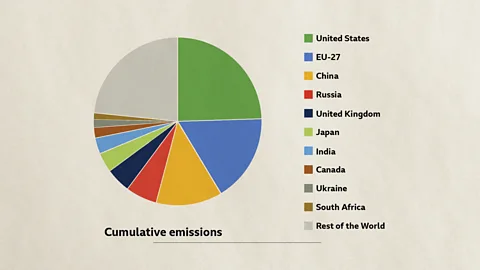 Luke Kemp/Javier Hirschfeld
Luke Kemp/Javier HirschfeldLethal autonomous weapons (LAWs)
One of the first intentional initiatives to attempt to develop general lethal autonomous weapons was the Defence Advanced Research Projects Agencies’ (Darpa) 1983 Smart Weapons Program, which contained a "Killer Robots" project. Its slogan was "The battlefield is no place for humans". Since then, interest in automated killers has grown. The most recent review of the lethal AI arms race found that the US was the outright forerunner, followed by China, Russia, South Korea and the EU. They are abetted by what the NGO Pax describes as 30 "high-risk" companies working on LAWs, or relevant technologies, who do not have any policy to ensure meaningful human control.
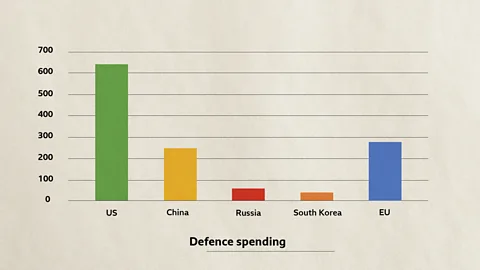 Luke Kemp/Javier Hirschfeld
Luke Kemp/Javier Hirschfeld Luke Kemp/Javier Hirschfeld
Luke Kemp/Javier HirschfeldNuclear weapons
The 1942-1946 Manhattan Project produced the 1945 successful Trinity test. The 1954 Castle Bravo test produced the first thermonuclear device. Both were deliberate, well-funded and organised enterprises by the US government. Scientists involved with the programme first performed calculations, and then took bets as to whether the first test would potentially ignite the atmosphere, killing all life on Earth. (Read more: The moments that could have accidentally ended humanity.)
Currently, 89% of nuclear weapons are held by two countries: the US and Russia. The entire global nuclear arsenal belongs to just nine countries. The production and maintenance of nuclear weapons is overwhelmingly reliant on just 28 major companies (primarily US based).
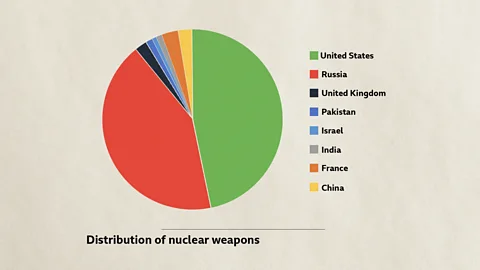 Luke Kemp/Javier Hirschfeld
Luke Kemp/Javier HirschfeldMass surveillance
There are concerns not just of global calamity, but the risk of dystopias, such as a long-lasting, AI-surveillance power totalitarian state. The social scholar and author Shoshana Zuboff at Harvard University has branded the modern era as the Age of Surveillance Capitalism. It is a situation in which human attention, experience and data are captured and commercialised en-masse.
It is dominated by a few, familiar titans: Alphabet (Google), Microsoft, Facebook, Amazon, Tencent, Baidu, Alibaba and Apple. All of which are in the top 10 largest companies in the world by market capitalisation. These are accompanied by tech firms tailored to provide cyberweapons and surveillance, such as Palantir and the NSO Group. The latter has recently been exposed by investigative journalists as having provided malware that has been used to infect the devices of activists, politicians, union leaders and journalists around the world, including by repressive regimes. (NSO denies any wrongdoing).
Big Tech and surveillance firms are accompanied by intelligence communities to form what I call a Stalker Complex that constantly watches the world. The breadth and intrusiveness of this mass surveillance apparatus is carried out by a small number of intelligence agencies such as the National Security Agency (NSA) and its UK counterpart the Government Communications Headquarters (GCHQ). While the future of AI surveillance technologies such as facial recognition technology is dominated by US and Chinese firms. China already possesses advanced surveillance systems, including widespread use of facial recognition, and even the deployment of drones to help enforce Covid-19 regulations.
Concentrated, captured and covert
There are three distinct lessons here. First, the production of human-made global catastrophic hazards is highly concentrated. The US military is responsible for pioneering work in nuclear and thermonuclear weapons, LAWs, surveillance, and AI. To this day, the US plays an outsized role in endangering the world. It is the world’s largest historical emitter, possesses the second largest, and most advanced nuclear arsenal, is the leader in developing LAWs, houses the largest agencies and firms working on surveillance, and has by-far the highest number of groups working on developing AGI.
 Ethan Miller/Getty Images
Ethan Miller/Getty ImagesSecond, the producers of such threats have frequently played an active role in suffocating action to address them. This is commonly referred to as "regulatory capture": regulatory efforts become captured by those that they are supposed to oversee. For climate change it is the fossil fuel lobby. For nuclear weapons, the arms race was stoked by the "bomber gap" and "missile gap" myths perpetuated by the US military industrial complex. Key US military and political figures claimed that the Soviets had a swelling superiority in strategic bombers and ballistic missiles. Later U2 surveillance flights showed that these were serious overestimates. While fictitious, it was enough to justify surges in defence spending.
A similar dyanmic occurs in international negotiations, with just a few key countries blocking regulation of catastrophic hazards. For biological weapons it was the US who was the primary culprit in preventing the adoption of a global verification scheme under the Biological Weapons Convention. For LAWs, approximately five countries (Australia, Israel, Russia, South Korea and the US) have actively blocked progress on banning or strongly regulating lethal autonomous weapons.
Third, producing the worst global threats is almost always done in the shadows.
Secrecy hazards
The history of anthropogenic global threats is a history of hidden information. I call these secrecy hazards: harms arising from intentionally concealed or obscured knowledge.
Secrecy hazards are almost always a tool of the Agents of Doom and history is rife with them. Both Castle Bravo and the Manhattan Project were among the most secretive projects in US history. The NSA’s mass surveillance programmes were intentionally hidden from the public eye while whistle-blowers such as Edward Snowden were marginalised and hunted for prosecution. The fossil fuel industry has spent decades burying its own private knowledge of climate change and obscuring scientific evidence. Research on LAWs and numerous other powerful weapons have been performed in confidential programmes in agencies such as Darpa.
As Tom Mueller shows in his overview of whistleblowing "Crisis of Conscience", the military and intelligence communities frequently use secrecy provisions, and companies deploy commercial non-disclosure agreements, to conceal corruption and avoid embarrassment and public scrutiny rather than hide genuinely dangerous information.
Risk and responsibility
All of this could change in the future. The potential threat of future bio-terrorism seems particularly notable given the rising accessibility of bioengineering tools. This has led some catastophic risk scholars to become concerned with "information hazards": the dissemination of true information that could cause harm.
Yet there appears to be little concrete reason as to why we should expect the burden of catastrophic hazards to undergo a dramatic shift from powerful states and companies to individuals and small groups. Currently, citizen terror fears tend to revolve around either far-flung thought experiments of "easy nukes" (nuclear weapons, or similarly destructive devices, that can be feasibly produced at a low cost by individuals and small groups) or naive extrapolation of technological trends assuming no limits or regulation. An empirical investigation of the past and present is a far more reliable basis for thinking about an uncertain future.
 Getty Images
Getty ImagesEven if a catastrophic global terrorist incident was to occur due to futuristic dangerous dispersed technology, it would almost certainly be traced back to the Agents of Doom in developing, overproducing, and preventing the regulation of such technologies.
Rather than fearing the public, scholars of catastrophic risk should see them as a wellspring of hope. The Agents of Doom should embrace rather than evade public scrutiny if they are genuinely concerned about global catastrophe. For all of these hazards there is abundant evidence that one of the best forms of risk management would be to hand their regulation and development over to citizens.
Public opinion polls across China, the US, Australia and the EU have showed strong majority support for greater action on climate change. In a poll across 26 countries, 61% opposed the use of lethal autonomous weapons. Europeans strongly favour an international ban on nuclear weapons. Similarly, a survey of six countries including the US and Israel found that a substantial majority of citizens in each country supported eliminating all nuclear weapons through an enforceable international agreement. Most recently extensive surveys by the Global Challenges Foundation found that strong majorities across numerous countries are open to creating a new supra-national body to manage global risks.
Notably this is from citizens who have often poor, distorted information. Deliberative democratic approaches in which juries or assemblies of randomly selected citizens are briefed by experts and then discuss among themselves, tend to vastly improve their judgement.
A popular way to explain the lack of action on global risk is cognitive biases. This misses the point. The problem isn’t these threats being publicly neglected; it is that they are actively hidden and any attempts at regulation are often delayed, distorted or destroyed.
Ironically, the common response during crises to empower governments and the Stalker Complex through emergency powers is entirely counter-productive. This "Stomp Reflex" is largely a movement of power from citizens to the Agents of Doom.
It is hard to characterise the actions of the Agents of Dooms as an "error", as Lord Martin Rees does. Yes, their goal is not to ruin the entire world, including themselves. But this is not about bias or motivation, it is about risk. The simple, unavoidable fact is that there are only a small number of powerful actors who produce most global catastrophic hazards and benefit from it. The motivation may not be cause global catastrophe, yet their actions are nonetheless deliberate. A drunk driver who gets behind the wheel may not intend to hit anyone, but they are still responsible for any inebriation-fuelled collision. Particularly if they are undertaking the dangerous journey to earn billions.
The citizen terror narrative is mistaken. Instead, calamity is being secretly birthed for profit and power by the Agents of Doom.
*Luke Kemp is a research associate at the Centre for the Study of Existential Risk at the University of Cambridge.
--
